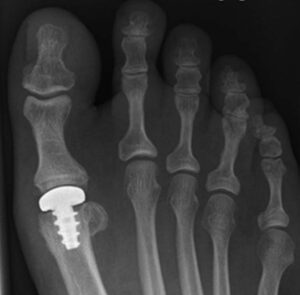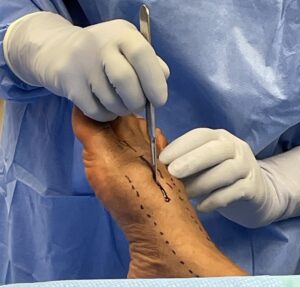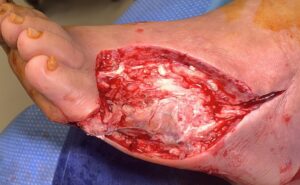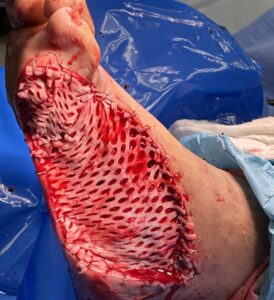Foot & Ankle Surgery
TOES
HAMMERTOE CORRECTION
Hammertoe correction surgery straightens and realigns a bent toe joint, relieving pain and restoring proper toe function. The procedure typically involves adjusting or removing part of the bone, releasing tendons, or repositioning ligaments to correct the toe’s position.
TOE SHORTENING
Toe shortening surgery involves removing a small section of bone to reduce the length of an overly long toe, improving comfort and alignment. This procedure helps alleviate pain, prevents shoe irritation, and enhances the toe’s appearance and functionality.
TOE LENGTHENING
Toe lengthening surgery involves adding bone or using a spacer graft to extend the length of a shortened or contracted toe, often to improve foot function. This procedure can reduce deformity, and enhance overall foot alignment.
TOE SLIMMING
Toe slimming surgery removes excess soft tissue or reshapes the bone to reduce the width or bulk of a toe, creating a slimmer appearance. This procedure is often done for improving the toe’s contour and comfort in footwear.
FOOT
ARTHRITIC JOINT REPLACEMENT

Big toe total joint replacement surgery involves replacing the damaged joint surfaces of the big toe with artificial implants to restore movement and reduce pain caused by arthritis or injury. This procedure helps improve function and alleviate discomfort.
BUNIONPLASTY® PROCEDURE

The Bunionplasty® procedure is the revolutionary, minimally invasive bunion surgery (MIBS) that focuses on aesthetic results and gets you back on your feet fast. No Casts No Crutches®
PLANTAR FASCIA RELEASE
Plantar fascia release surgery involves cutting part of the plantar fascia ligament to relieve tension and reduce chronic heel pain from plantar fasciitis. This procedure aims to improve mobility and comfort, especially when other treatments have not provided sufficient relief.
HEEL SPUR RESECTION
Heel spur resection surgery involves removing a bony growth, or spur, from the heel bone to relieve pain and reduce irritation in the surrounding tissues. This procedure is often performed when conservative treatments fail, allowing for improved comfort and mobility.
REMOVAL OF MASS
Surgery for the removal of a soft tissue mass involves excising a growth, such as a cyst or benign tumor, from the surrounding tissues to alleviate pain or prevent further complications. This procedure helps restore normal tissue function and reduces the risk of recurrence or irritation.
ANKLE
ACHILLES TENDON REPAIR
 Achilles tendon repair surgery involves suturing a torn or ruptured Achilles tendon to restore its strength and function. The procedure may include reattaching the tendon to the heel bone or repairing any damage to the tendon fibers.
Achilles tendon repair surgery involves suturing a torn or ruptured Achilles tendon to restore its strength and function. The procedure may include reattaching the tendon to the heel bone or repairing any damage to the tendon fibers.
ANKLE ARTHROSCOPY
Ankle arthroscopy is a minimally invasive procedure in which small incisions are made to insert a camera and surgical instruments into the ankle joint for diagnosis and treatment. This technique allows the surgeon to remove damaged tissue, repair cartilage, or address other joint issues with minimal disruption to surrounding structures.
ANKLE LIGAMENT REPAIR
Ankle ligament repair surgery involves reconstructing or reattaching torn ligaments in the ankle to restore stability and prevent further injury. The procedure typically includes suturing or grafting new tissue to strengthen the ligament, improving function and reducing pain.
ANKLE FUSION
Ankle fusion surgery involves joining the bones of the ankle joint together to eliminate pain and restore stability, typically after severe arthritis or injury. The procedure uses metal plates, screws, or rods to hold the bones in place while they heal and fuse into a single, solid structure.
RECONSTRUCTION SURGERY
FOREFOOT RECON
Forefoot reconstruction surgery addresses multiple deformities or joint issues in the front part of the foot, often involving realignment of bones, tendons, and ligaments to restore proper structure.
DIABETIC CHARCOT RECON
Diabetic Charcot reconstruction surgery aims to correct the deformities caused by Charcot foot, a complication of diabetes that leads to bone and joint damage. The procedure often involves realigning bones, repairing damaged ligaments, and sometimes using internal or external fixation devices to restore foot structure and improve mobility.
DIABETICS
INCISION AND DRAINAGE ULCER
 Incision and drainage of an ulcer involves making an incision with a surgical blade to release pus or fluid from an infected ulcer, promoting healing and reducing pressure. This procedure helps prevent the spread of infection and provides relief from pain and swelling.
Incision and drainage of an ulcer involves making an incision with a surgical blade to release pus or fluid from an infected ulcer, promoting healing and reducing pressure. This procedure helps prevent the spread of infection and provides relief from pain and swelling.
WOUND DEBRIDEMENT

Wound debridement is the surgical removal of dead or damaged tissue from a wound to promote healing and reduce the risk of infection. This procedure helps to create a clean wound bed, allowing for better tissue regeneration and faster recovery.
BONE BIOPSY
A bone biopsy involves removing a small sample of bone tissue for examination to diagnose conditions such as infection, cancer, or other bone disorders. The procedure is typically performed using a needle or small incision, guided by imaging techniques, to minimize damage to surrounding tissues.
ANTIBIOTIC BEADS
 Surgery using antibiotic beads involves placing beads impregnated with antibiotics directly at the site of infection to deliver localized treatment and prevent further bacterial growth. This method is commonly used in orthopedic procedures to treat bone or joint infections, promoting healing while reducing the need for systemic antibiotics.
Surgery using antibiotic beads involves placing beads impregnated with antibiotics directly at the site of infection to deliver localized treatment and prevent further bacterial growth. This method is commonly used in orthopedic procedures to treat bone or joint infections, promoting healing while reducing the need for systemic antibiotics.
SKIN GRAFT APPLICATION
 Surgery using a donated skin graft involves transplanting healthy skin from a donor site to cover a wound or burn area, promoting healing and protecting the underlying tissue. This procedure helps improve the appearance and function of the affected area, while reducing the risk of infection and further complications.
Surgery using a donated skin graft involves transplanting healthy skin from a donor site to cover a wound or burn area, promoting healing and protecting the underlying tissue. This procedure helps improve the appearance and function of the affected area, while reducing the risk of infection and further complications.

